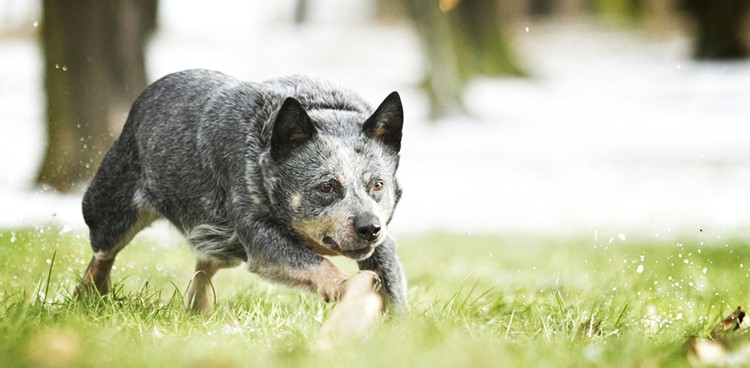
You can thank a dingo and a blue merle border collie for the current-day Australian cattle dog—this original crossbreed started it all in 1840s Australia. Later, brothers Jack and Harry Bagust bred the pooch with a Dalmatian in an attempt to create a loyal dog able to corral wild cattle without being spooked by horses. Though the result was a faithful, livestock-loving canine with a dappled blue or red coat, the Bagusts weren’t finished yet—they needed an infusion of hard-working spirit. The brothers coupled their creation with an Australian kelpie—a star herder—finally resulting in the Australian cattle dog, an active, protective dog with an undisputed ability to work with cows. Also called blue heelers, the pups grew so swiftly in popularity in their native country that they earned the nickname “Queensland herder.”
Breed Standard
In 1893, writer and environmentalist Robert Kaleski began breeding Australian cattle dogs. He drafted the standard for the breed at the turn of the 20th century, basing it on the guidelines for dingos. Though casual breeders initially opposed it, the standard was approved by the Cattle and Sheepdog Club of Australia and the original Kennel Club of New South Wales in 1903. Presently in the US, the breed is part of the American Kennel Club’s Herding Group.
Appearance
Compact and muscular, Australian cattle dogs are strikingly symmetrical—from their wide-set ears and intense brown eyes to stocky hindquarters and a slightly curved tail. Whether red or blue, their coats are always marked with a salt-and-pepper speckle and they often have black spots around their eyes, too. The dogs aren’t born like that, though—puppies enter the world completely white and develop patterns gradually with age.
Personality
Always focused on the task at hand yet acutely aware of their surroundings, Australian cattle dogs possess a strong desire to protect their human and animal families. While the dogs are not considered aggressive, they may exhibit a determined and defensive nature in the face of danger. Even so, they are exceedingly affectionate. As Wes Jarrell of Prairie Fruits Farm & Creamery in Champaign, Ill., says of Blue, his Australian cattle dog mix, “When friends give us hugs, he will jump right up in the middle. He wants to be hugged, too.”
Activity
Put this pooch to work! Highly energetic and bred for labor, these dogs are happiest when carrying out tasks they were trained to do—herding and more. At Prairie Fruits, Blue can be found greeting guests, chasing rabbits, and rounding up chickens. Jarrell wouldn’t have it any other way. “A bored Australian cattle dog will quickly become antsy, and possibly neurotic,” he says. However, this breed learns fast, and with a dedicated trainer, the dog’s gentle instincts can benefit livestock in many ways.
Feature Photo Credit: Best dog photo | Shutterstock




